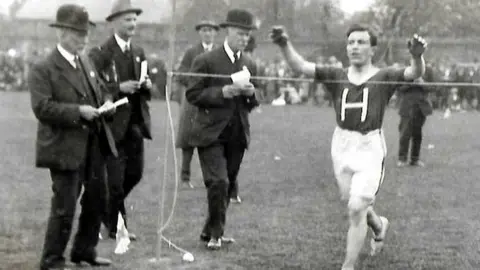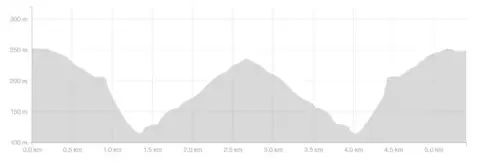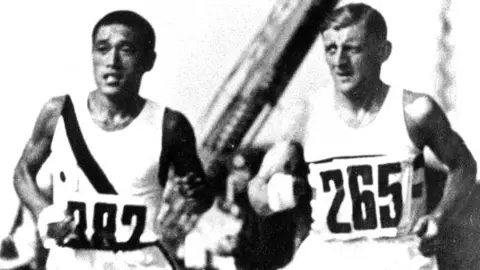Cheats, bets and killer hills: The 'brutal' race which keeps on running
 Derek Brailsford
Derek Brailsford"Horrific" - that's the single word which sprang to the mind of Olympic gold medal winner and London 2012 supremo Lord Coe when he was once asked to describe his memories of Yorkshire's Hallam Chase fell race. And perhaps rightly so...
The Chase, which is believed to be the world's oldest continuously held fell race and which celebrates its 160th year in 2022, has the reputation for being a tough challenge - even for aspiring Olympians, as Sebastian Coe once was.
And yet, as he freely admitted, he kept coming back for more.
The race, which is held annually in Sheffield, has also attracted some colourful and controversial characters to take part over the past 160 years, including runners in disguise and the case of the identical twins caught cheating - all in the name of victory, of course.
At first glance, the Hallam Chase may seem like a leisurely run in the South Yorkshire countryside.
However, as a past Chase participant myself, I think it's fair to say that couldn't be further from the truth.
Starting at Hallam FC's Sandygate ground - which, incidentally, is the world's oldest football ground - Hallam Chase runners then pelt down seemingly sheer rock faces into the Rivelin Valley.
Participants are then expected to climb back up to Stannington church before setting out on the return journey - and that stage is far more difficult, with parts of the course seeing some runners near to exhaustion drag themselves over boulders on their hands and knees.
I've been told that in total the 3.25 mile (5.2km) course involves the equivalent of climbing an average domestic staircase around 100 times.
Perhaps it's no wonder, then, that Lord Coe had strong feelings about the competition - but, like many of those who have taken part in it, he told me he loved the challenge.
 Alamy
AlamyCoe, who scrambled across those rocks trying to complete the Chase while he was a teenage member of the Hallamshire Harriers, said completing the course "was almost a rite of passage" for many runners in South Yorkshire.
Others I've spoken to said it was simply "murder". They're probably all correct.
Derek Brailsford, whose father Arthur won the event back in 1926, told me: "It's the hardest run I've ever run."
Keen to experience what his father did 90 years before, Derek tackled his life-long dream for the first time in 2016 - at the age of 70.
Describing how, while watching his father compete, hundreds of people would stand two-deep along Den Bank, one of the race's final climbs, he said: "It was so popular, the crowds that used to turn up were massive."
At its height, up to 20,000 people would cheer Hallam Chase competitors along the course, and Derek said in his father's era some of those spectators would even place bets on the result.

But, of course, the race's history goes much further back in time to when Queen Victoria was still on the throne.
The handicapped event started in 1862 as a way of advertising Hallam FC's upcoming season.
At a time when the laws of football hadn't even been officially drawn up and the game was just beginning to take off as a mass event, running and athletics were already huge spectator sports.
Faster runners would be given a time handicap so they would set off chasing slower runners. But, to stand a better chance of winning, elite runners would pretend to be slower to be given a smaller handicap.
"People trained in secret, tried to get a better handicap and had big money placed on them," Keith Whitelam, Hallamshire Harriers coach told me.
Keith is training the next generation of athletes who will compete in races which are a far cry from the sort of competition the Hallam Chase once was.
He said: "With the professional runners, they would run their previous races not particularly well to get a good handicap and then turn up in disguise."
These dishonest types hoped the bookmakers and pub landlords, who would pay the other competitors, would not recognise them, he added.
But, according to Keith, that wasn't all: "They had other people on the course to disrupt others - 'nobblers' they were called - closing gates, getting in the way.
"And threats as well. If there was heavy money on this person and the bookies were likely to lose a lot, they were told, 'you don't win this race'."
 Derek Brailsford
Derek BrailsfordSince its inception, the course and distance of the Hallam Chase has changed slightly, but it has always remained a handicapped run.
The idea is that everyone finishes around the same time and the winner may not always be the fastest, with different start times being given to runners when they arrive on race day.
For Derek Brailsford, stories from his father's time as a Chase competitor live long in his memory, including how his 1926 victory upset the bookies as he "wasn't meant to win".
Derek also told me there was a story of identical twins, one running half the course before the other twin took over at the turnaround point on the other side of the valley.
"That's why afterwards, when they turned round at Stannington, they'd be splashed with a water dye so they knew if they'd gone halfway round and finished off the course."
During the 1900s, betting on the Hallam Chase started to fall out of favour.
Former race organiser Mike Redman told me that the local police tried to stop the gambling a number of times, before finally "getting in on the act" when they found it was an easy way to make a bit of quick cash.
Mike, 80, helped organise the race for 15 years, starting in the 1990s when he took over from local running legend Malcolm Douthwaite.
Running the "killer" race was like taking part in the Olympics, Mike said, with people from as far afield as Kenya asking to join the event.
 Strava/Oli Constable
Strava/Oli ConstableThe Hallam Chase course record stands at a staggeringly swift 19 minutes and 42 seconds, which was set in 1968 by Trevor Wright. Since then, many have tried to beat that time, but fallen short.
It seems it's unlikely to be broken any time soon, either. Even Olympic gold medallist Lord Coe was minutes off the time when he took part.
Coe admitted to me that despite finding the Chase "pretty brutal", it was "actually great fun" and helped his foundation as a runner.
"It was incredibly hilly but running across terrain like that had such a big impact on the future direction of my career.
"If you can deal with the physical challenge of that when you are 14, then there's nothing you can't handle running on the track," he said.
In fact, Lord Coe was the second-known Olympian to have used the Chase as the starting blocks for a prestigious running career.
Local lad Ernie Harper won the race in 1922, going on to win a silver medal at the 1936 games at Berlin in Nazi Germany.
 Alamy
AlamyJust under 100 years on from Ernie's victory, about 60 athletes took on the Hallam Chase challenge in 2021 - and Pat Goodall was one of them.
Now 67, Pat told me she had lost count of the number of times she had taken part in the race and she rather sheepishly admitted that as a runner she preferred tougher fell races like the Chase.
"I like running off-road. I know the area, I actually like the ups and downs. I'm not particularly good at flat road running."
Taking to the hills satisfied her "inner child" and would keep her coming back for more, Pat added.
"There's an appetite and a loyalty to the Hallam Chase. You have all that camaraderie at the beginning.
"There's the joshing about 'your handicap's not fair, you should be in front of me'. It's all good fun."
And, as a new group of determined runners gets ready to mark the 160th anniversary of the Chase on 31 May, what of its future?
If Alex Day, who is about to hit the Hallam hills for a second year running, is anything to go by, it should be secure.
Having first signed up to the Chase in 2021, Alex - currently in training for several marathons this summer - said he wanted to be "part of its history".
"It is a brutal course, but a nice distraction was thinking of all the running ghosts and stories that must be on the course.
"It's been going for 160 years. Here's hoping it gets another 160 and that more runners get to take on the challenge."

Follow BBC Yorkshire on Facebook, Twitter and Instagram. Send your story ideas to yorkslincs.news@bbc.co.uk.
